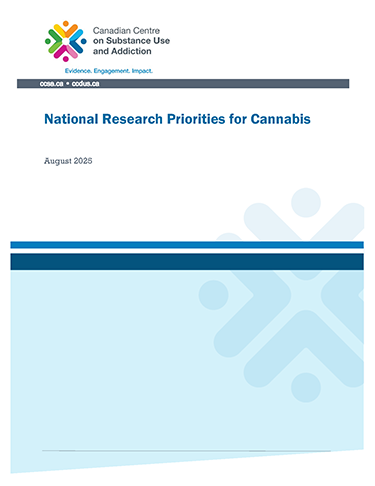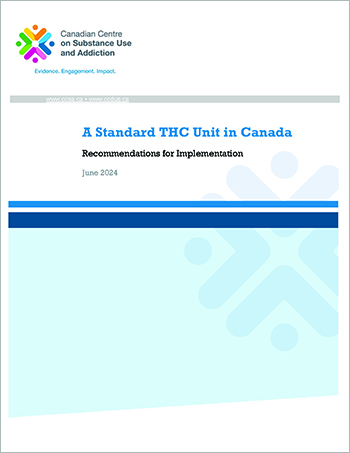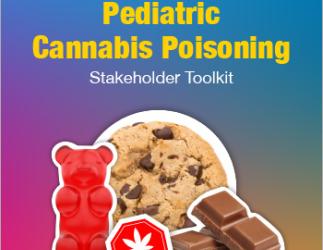Most Recent Publications on Cannnabis

National Research Priorities for Cannabis
Synthesizes the results of CCSA’s meeting in collaboration with Health Canada, the Canadian Institutes of Health Research, Institute of Neurosciences, Mental Health and...

A Standard THC Unit in Canada: Recommendations for Implementation
Summarizes recommendations that emerged from a two-day meeting we hosted with national and...

Medical Use of Cannabis and Cannabinoids
A handout with frequently asked questions for people considering using cannabis for their health conditions. Explains what cannabinoids are and what risks to consider when...

What does research say about treating medical conditions with cannabis and cannabinoids?
Examines levels of evidence for using cannabis for various conditions such as...

Pediatric Cannabis Poisoning Stakeholder Toolkit
Presents key facts, social media graphics and messaging to help organizations raise awareness of pediatric cannabis poisoning through public education campaigns. The collateral...
What is Cannabis?
Cannabis is a plant that is known for its psychoactive properties. There are various cannabis products, including plant materials, cannabis oils, concentrated extracts, edibles, tinctures and creams. These products are used for their physical and cognitive effects and for medical and nonmedical purposes. People usually smoke cannabis, but they can also consume it in other ways, such as vaporization (vaping) and in edibles.
Cannabis flowers secrete more than 100 different chemical compounds, known as cannabinoids. When consumed, these compounds bind to cell receptors in the body and change the way these cells communicate with one another. Two of the best-known cannabinoids are THC and CBD:
- THC (delta-9-tetrahydrocannabinol) is the primary psychoactive component of cannabis and is responsible for the high that individuals experience.
- CBD (cannabidiol) does not produce a high, but it can cause drowsiness. It is being studied for use in medical applications, such as relieving pain, nausea and symptoms of other chronic conditions.
Featured Resources
Heading
Pediatric Cannabis Poisoning Stakeholder Toolkit
Presents key facts, social media graphics and messaging to help organizations raise awareness of pediatric cannabis poisoning through public education campaigns. The materials convey the important message of keeping cannabis edibles safely stored and out of reach from children, in the same way we do for other dangerous household items.


Heading
Video: The Effects of Youth Cannabis Use on the Developing Brain - Myth Busting
Panel discussion about the myths youth hold about marijuana.

Heading
Video: Thinking of using cannabis while pregnant or breastfeeding?
Video explains that exposure to cannabis can affect a baby’s mental and physical development, and there is not enough evidence to support using cannabis to treat morning sickness nor pain.
Heading
Demographic Trends for Cannabis Use
Cannabis use is slowly on the rise in Canada, according to the 2022 Canadian Cannabis Survey. Use among the general population (aged 16 years and older) increased from 25% in 2021 to 27% in 2022. Provincial and territorial estimates ranged from 18% to 41%. Cannabis use was highest among people aged 20–24 years (50%), followed by those aged 16–19 years (37%) and those aged 25 years and older (25%). The biggest change in users occurred in the 25 years and older group, which increased from 22% in 2021 to 25% in 2022.
27%
50%
25%
Get to know our team of experts
Bryce Barker, PhD, CE
Senior Knowledge Broker
Area of Expertise:
Doug Beirness, MSc, PhD
Senior Research Associate
Area of Expertise:
Alexander Caudarella, MDCM CCFP AM ABAM(d)
CEO
Area of Expertise:
Karen Cumberland, MPA
Vice President, Strategic Initiatives and Community Outreach
Area of Expertise:
Timothy Deloughery, CCAC, CCS-AC
Substance Use Health Specialist
Area of Expertise:
Robert Gabrys, PhD
Senior Research and Policy Analyst
Area of Expertise:
François Gagnon, PhD
Senior Scientist and Special Policy Advisor
Area of Expertise:
- More Area of Expertise
Heading
Guidance, Tools and Resources
CCSA produces research-based publications, tools, and resources to support evidence-based decision-making on substance use health issues. Select your area of interest from the six categories below:
Heading
Substances
Delve into key resources on commonly used substances, such as alcohol, cannabis, opioids, stimulants and psychedelics. Learn about their effects, usage patterns, associated health and social consequences, and harm reduction considerations
Heading
Personal and Societal Impacts
Get insights on the personal and societal impacts of substance use and addiction , including gambling and impaired driving, and their effects on health, safety, and social well-being. Learn about effective prevention and harm-reduction strategies in various sectors.
Heading
Communities
Communities share common interests, values or goals, and interact with one another to build relationships and help networks. These materials support more inclusive, equitable, and community-informed responses to substance use and addiction. Dive into resources highlighting people with lived and living experience, stigma, sex- and gender-based analysis, Indigenous Peoples, and housing.
Heading
Treatment and Prevention
Explore medical, psychological, and social approaches aimed at helping individuals avoid or recover from substance use disorders. Get the facts on public health topics and learn about collaborative efforts to reduce stigma and promote more equitable, inclusive responses to substance use.
Heading
Youth
Learn about factors influencing substance use in young people, including childhood trauma and brain development, and get tools to support adult allies in leading meaningful, evidence-informed conversations with youth. Content promotes early prevention, harm reduction and supportive environments for youth up to age 25.
Heading
Substance Use and the Workplace
Substance use has a significant impact on the workplace, potentially affecting safety, productivity and employee well-being. Explore research on substance use in various industries. Resources support workplace leaders in building more supportive, stigma-free environments through practical strategies, improved approaches and initiative-taking education.
Latest CCSA Updates
Joint Statement from the Canadian Centre on Substance Use and Addiction and the European Union Drugs Agency
Alexis Goosdeel, Executive Director of the European Union Drugs Agency (EUDA), and Dr.
Alexis Goosdeel, Executive Director of the European Union Drugs Agency (EUDA), and Dr.